5. Sanadine Mineral Separation from Rhyolitic Basalts¶
Standard protocol for sanadine mineral separation. If obtaining sanadine, first crush the sample through a range of sizes and determine where the crystals are likely to be most abundant.
- Crush the majority of the material into various size fractions.
20, 30, 45, 60, 80 mesh
841, 595, 354, 250, 177 microns
5.1. Large Jaw Crusher Method¶
Description
This method of crushing a rock is meant for large amounts of material. Ideally the sample would only need to go through the large crusher once and enough fine material should be generated for mineral separation.
Procedure
5.1.1. Workspace Preperation¶
Wipe down all surfaces with water and ethyl alcohol.
Inspect and clean equipment.
5.1.2. Clean Large Jaw Crusher¶
Procedure to clean the large jaw crusher in Wilkenson.
Steps
Remove the large steel panel that covers the motor to reach the rear plate bolt.
Remove bolt and pull out the rear crushing plate.
Take out the two steel plates.
Spray the plates with ethanol and scrub with a metal brush.
Wipe down and spray a final time with acetone and be sure that the plates are dry.
Use compressed air blow out all the crusher to remove dust and small rock pieces.
Ensure that there are no rock grains that are wedged in the sides of the bae of the crusher.
Re-instll the steel plates and the bolts. Be careful when tighting the bolt nut. The nut #oes not need to be heavily torqued down.
Wipe down the sample collection tray and install beneath the crusher.
5.1.2.1. Operating the Large Jaw Crusher¶
Procedure for crushing samples using the large jaw crusher in Wilkinson. The large jaw crusher is generally used for crushing large amounts of sample. The size of the rock should be no larger than the size of a fist.
Steps
Check and make sure the plates and properly installed.
Turn on the crusher.
Place a single piece of rock in the crusher. If the material consists of smaller than fist #ized pieces, you can pour in a small amount at a time.
If crushing a lot of material, be sure to occasionally check the pan and make sure the #rushed material is not overflowing.
Turn off the crusher.
5.1.3. Sieving samples after crushing¶
Steps
5.1.3.1. Setting up your work area for sieving¶
Gather appropriate sieves.
Check sieves for stuck grains and clean if necessary.
Layout a piece of paper for each sieve you will be using, plus an additional for sample transfer.
Label each piece of paper with the corresponding sieve size.
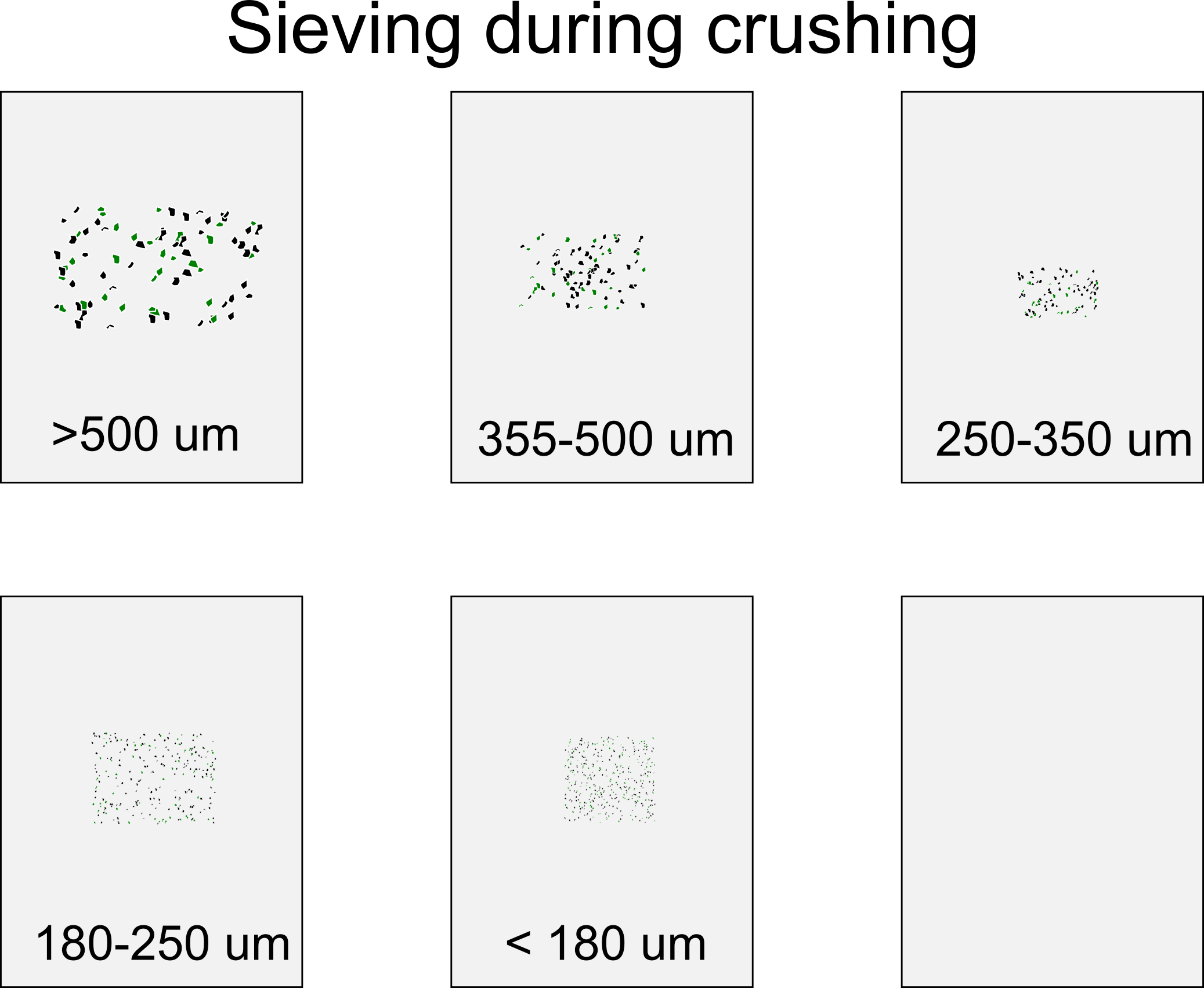
Check Sieves
In general, always check a sieve before using it to ensure that there is no cross contamination.
Procedure
Wipe down top and bottom of sieve with a tech wipe and ethanol.
Check for grains stuck by looking through the sieve. This is done best by using a bright background (e.g. hold up to light) in order to see grains clogging the mesh.
If there are grains, refer to cleaning methods in sieve_clean.
5.1.4. Sieving Method¶
Sieving is conducted by using all metal sieves for a given range of grain sizes.
Steps
Set out a piece of paper for each sieve plus the pan and label them with the sieve range and sample ID. These will be used to pour the contents of each sieve as the sample is separated.
Gather available sieves from 150 µm to 350 µm in at least 100 µm increments. Using larger increments will make it more difficult during the picking stage. It is best to have a uniform grain size distribution.
Check sieves for errant grains within the mesh and remove. Proceed with caution as applying pressure on the mesh when removing grains. Too much pressure can warp and damage the sieve, reducing it’s lifetime.
Wipe each sieve with ethanol or acetone. This helps remove fine particles that may contaminate samples.
Stack the sieves along with the bottom pan and pour in enough sample to make a few layers of grains. Filling sieves with too much material will slow down how quickly you can reliably sieve the sample.
Shake the sieves and once the sample appears to have been sieved remove the top sieve and dump out it’s contents onto the labeled paper. Continue to shake the sieve while occasionally tapping the sieves on the table, encouraging the finer material to fall through the sieve.
After working yourself through the first round, repeat the steps by re-stacking the sieves and pouring more sample in until the sample is complete.
5.1.5. Progression Sieving and Crushing¶
Sieving and crushing a sample in conjunction with one another allows you to efficiently breakdown the sample. Once the sample has been initially crushed to ~<5 mm in size, the sample should be sieved. The coarsest sieve should be taken and put back into the crusher. This can be repeated until the jaw crusher no longer becomes efficient in crushing the material.
5.1.6. Shaking Sieves¶
Stack the determined sieve sizes. It is best not to go over 4 sieves.
Pour sample into the top most sieve so that it covers roughly half of the sieve.
Begin gently shaking the sieve side to side. Occasionally gently tap the stack of sieves on a table to knock loosely held grains to the sieve below. Continue to shake until it appears that the finest material has left the topmost sieve.
Remove the topmost sieve and place it on the labeled sheet. Continue the shaking motion and continue this process until you have gone through each of the sieves.
Once you have gone through each of the sieves and emptied them on to their respective sheets, repeat the process until you have gone through the rest of the sample.
Finally Clean the workspace
5.1.6.1. Clean Sieves¶
Working over a sheet of paper, or directly over the rock waste bucket, scrub mesh with a fine wire or nylon brush to dislodge grains. Be careful not to apply too much pressure, which could deform the mesh.
With sieve turned upside down, apply back-and-forth strokes of the brush along the strands of the mesh, in circles, etc., to dislodge as many grains as possible.
Turn sieve over and repeat step (a) for the inner side of the mesh.
If necessary, run a needle tool along the wire mesh to pluck out stuck grains. Do not poke/scrape/scratch with a lot of force, as this could damage the mesh.
Repeat steps (a) through (c) as needed until all grains are removed.
Use an air hose to blow dust out of the mesh and off the metal surfaces of the sieve.
Give metal surfaces a final wipe down with a paper cloth and ethanol or acetone.
5.1.7. Clean Large Jaw Crusher¶
Procedure to clean the large jaw crusher in Wilkenson.
Steps
Remove the large steel panel that covers the motor to reach the rear plate bolt.
Remove bolt and pull out the rear crushing plate.
Take out the two steel plates.
Spray the plates with ethanol and scrub with a metal brush.
Wipe down and spray a final time with acetone and be sure that the plates are dry.
Use compressed air blow out all the crusher to remove dust and small rock pieces.
Ensure that there are no rock grains that are wedged in the sides of the bae of the crusher.
Re-instll the steel plates and the bolts. Be careful when tighting the bolt nut. The nut #oes not need to be heavily torqued down.
Wipe down the sample collection tray and install beneath the crusher.
5.2. Wash Sample Method¶
Sample is rinsed in tap water and put into an ultra-sonic bath for a few minutes. The sample is rinsed a few more times until all the finer material is washed away. Once the water is clear, a final rinse in DI water is conducted before being placed in an oven to dry at 55°C.
Steps
Select the desired size range to continue processing and wash.
Select a beaker size based on the size of your sample. It is best to select a beaker large enough so that it is only filled ~1/4 of the way with the sample. Selecting a beaker too small will make it more difficult to fully rinse and wash the sample and make it longer to dry in the oven.
Rinse the sample in tap water until water is clear. To accomplish this begin by rinsing the sample a few times to remove the loosely held dust and smaller material.
Fill the beaker with water and place in an ultra-sonic bath for 2-5 minutes.
After, rinse the sample until the water is clear.
Once the water is clear enough, drain as much water as possible and place the beaker into an oven at a temperature no greater than 55 °C. To expedite the sample drying, rinse the sample a few times with acetone and place it in the oven. The acetone will evaporate quickly and expedite the drying process.
After the sample is dry, re-sieve the sample before proceeding to the next step.
Magnetically separate feldspars from glass and other crystals.
6. Separation of Sanidine Crystals in Pumice/Dacite/Rhyolite¶
- Test each fraction for the presence of sanidine.
Use peppermint oil to find the fraction with enough Sanidine crystals needed for the experiment.
Determine fraction to continue.
Resieve chosen fraction
Separating the feldspars from the rest of the crystals and glass is important for obtaining a clearer picture of the amount of feldspars that are present in the sample. When the feldspars are magnetically separated, you’ll be left with a potential mix of sanidine, plagioclase and quartz.
Magnetically separate feldspars from glass and other crystals.
- Leach crystals in 15% HF for 5 (6-8 mins) Minutes in the large ultrasonic bath
Leach only one sample at a time.
Post leach, let crystals sit in the sonic bath for 2 hours.
After leaching and a long session in the ultrasonic bath, it is important to resieve the sample because the HF will alter the size of the grains and the ultrasonic bath will break apart crystals. Select a representative fraction to pick the grains.
Resieve fraction
Conduct Heavy Liquids for Sanidine separation
Pick Sanidine crystals from float.
Pick plagioclase crystals from sink. * May need to frantz quartz from the plagioclase fraction if unable to disern between the two.
6.1. HF Leach¶
The procedures is to clean single crystal separates of any lingering alteration or to remove adhering glass.
How to pick feldspar separates for Ar/Ar Analysis.
Safety
Brightness of scopes.
6.1.1. Workspace Preperation¶
Wipe down all surfaces with water and ethyl alcohol.
Inspect and clean equipment.
Picking Tools
Plates
Choose a plate that has a constrasting color to the types of grains you are working with. For plagioclase separation it is best to pick with a glass plate using transmitted light. This allows the identification of crystals with inclusions, which need to be avoided.
Picks
Brush
Placing sample on a plate
Pour a small amount of the sample onto one side of the picking plate. Then, using a brush, spread a thin line of grains across the plate. A thin line will make it easier to focus on each grain while being able to compare it to other grains.
Take a small amount grains from the pile and spread them across the plate.
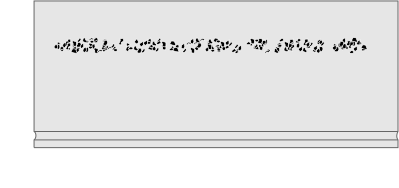
To begin picking grains, you want to quickly pick grains that are uniform and represent the majority of the sample and avoid signs of alteration or inclusions. You don’t want to spend too much time analyzing each grain, another more careful pass will be made on the grains in the next step. For now, quickly reject grains that do not look adequate.
Bring ‘good’ grains to the bottom of the plate and ‘bad’ grains to the top.
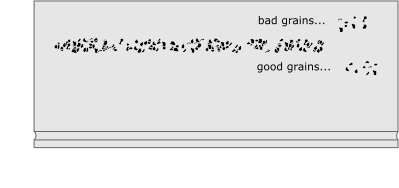
First Pass grain picking
You should end up with two distinct piles of grains of ‘good’ and ‘bad’.
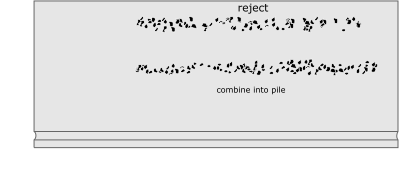
Second Pass
Once the line of grains has been gone through, brush the ‘good’ grains to the bottom of the plate and recombine them into a pile. Here you will be able to compare the grains more closely to one another and reject grains that appear to be more altered than others.
From the second pass pile, move grains into the trench at the bottom of the plate.
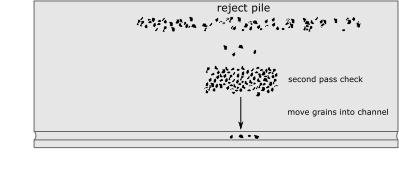
Go through the pile and move the accepted grains into the ‘trench’ and move the rejected grains up to the top to the plate with the rest of the grains.
Brush good grains into a vial.
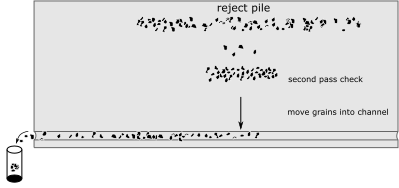
6.2. Pack samples for Irradiation¶
Procedure to pack picked samples for irradiation.
Steps
Weigh samples to the desired amount to irradiate. Generally enough for two analyses.
Put pre-made aluminum capsule in the pack plate.
Use funnel to pour sample into capsule.
Clip top of the capsule to leave a few millimeters of aluminum to fold over the material.
Make four folds over the material and use the streel stamp tool to mould the capsule.
6.3. Short-term project archivel¶
Projects that have had all samples prepered and irradiated can be move down to into the short-term storage in Burt Basement Room 05.
Steps
Gather all the samples related to the given project.
Ensure that each sample is properly labeled and contained in a singular bag.
Check and make sure a tyvek label is in each sample bag labeled with the 1) Project ID, Project PI, and the sample name.
Place all samples in the same storage bin. Print out a list of all the samples in the bin.
Update the Argon Lab Spreadsheet Log archive location to Burt-05
